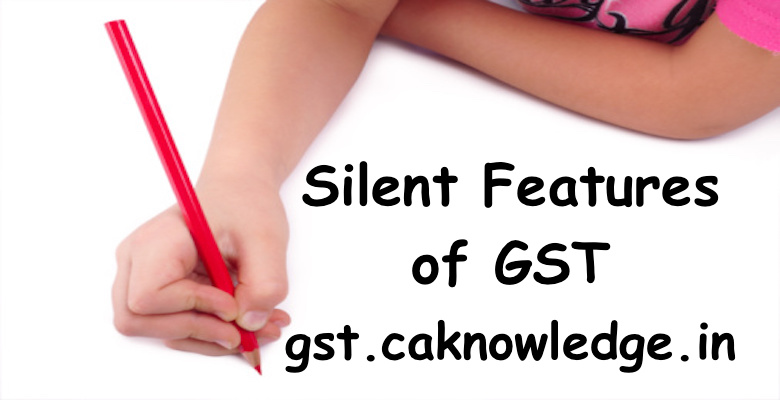Silent Features of GST, Features of Goods and Service Tax Law. List of all Features of GST Law India 2021. Check Silent Features of Goods and Service Tax. Check Basic Features of GST India. this article we provide list of all Silent Features of GST. Recently we provide complete details for GST Registration,GST Login Procedure, GST Rates 2021, GST Return Online Process, GST Refund Details, HSN Code List etc… The significant features of GST are likely to be as follows.

Silent Features of GST (Goods and Service Tax)
- GST is a dual indirect tax structure wherein both centre and states have the power to levy tax.
- GST does not distinguish between goods and services.
- GST is applicable on Supply of Goods and Services. In GST regime, all supply such as sale, transfer, barter, lease, import of services etc of goods and/ or services made for a consideration and in some cases without consideration (like permanent transfer of business asset) will attract both Central GST (to be levied by Centre) and State GST (to be levied by State).
- The CGST and SGST would be applicable to supply of all goods and services made for a consideration except for the exempted goods and services, goods which are outside the purview of GST and the transactions which are below the prescribed threshold limits.
- The CGST and SGST are to be paid to the accounts of the Centre and the States separately. Taxes paid against the CGST and SGST will get input tax credit (ITC) within the CGST and SGST chains respectively but cross utilization of ITC between CGST and SGST would not be allowed.
- The administration of the CGST will be with the centre and that of SGST with the states
- Since the CGST and SGST are to be treated separately, they are to be paid to the accounts of the Centre and the states separately.
- GST is payable at the time of supply and hence the determination of time and place of supply is crucial as far as levy of GST is concerned.
- GST would be payable on the transaction value. Transaction value is the price actually paid or payable for the said supply of goods and/or services between un-related parties.
- GST will allow ‘Input Tax Credit’ to the business houses without any denial or restrictions
- Inter-state supply of goods and services for consideration are to attract additional tax.
- The tax payer would need to submit periodical return in common format to both the central and state GST authority. Each taxpayer would be allotted a PAN-Linked Taxpayer Identification Number with a total of 13/15 digits which would bring the GSTPAN-Linked System in line with the prevailing PAN-Linked-Income Tax facility.
- There would be 33 GST Laws (31 for states and 2 for UnionTerritories)
- There would be time limit for Show Cause Notice (SCN) ranging from 3 to 5 years.
- GST rate is determined keeping in view that it would yield at least the same revenue to the centre and states as collected through the various indirect taxes that would be subsumed under GST. Such rate is known as Revenue Neutral Rate (RNR).
- Though rates of the GST are never the part of provision of the act but as promised in the Rajya Sabha by Hon. Finance Minister Shri ArunJaitely that upper limit of the tax will be part of the law and therefore upper limit of the tax rate of 14% has been provided in Section 8(1) of CGST /SGST Law) and and 28 % on IGST (Section 5(1) of IGST Law). It is expected Clean Cess and Swachha Bharat Cess will also be additionally imposed on the luxury goods and beverages. Needless to say, no ITC credit will be available on such cess. Click Here for more details.
Recommended Articles
- GST Rate
- GST Registration Status
- GST Login
- How to Register and Update DSC
- GST Registration
- GST Forms
- HSN Code List
- ITC under GST
- GST Due Dates
- Tax Payment in GST
- GST Refund
- Place of Supply under GST
- Returns Under GST
- GSTR 1 Return Checklist
If you have any query or suggestion regarding “Silent Features of GST, Features of Goods and Service Tax Law” then please tell us via below comment box.
